|
In this section:
|
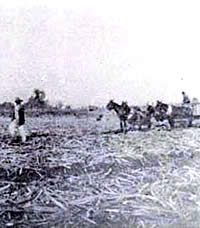
Harvesting and loading sugar at Masterson
Plantation. Photograph courtesy of the Brazoria County
Historical Museum.
|
|
The alluvial soils of this Gulf Coast Plain were
a source of great wealth for the sugar planters.
|
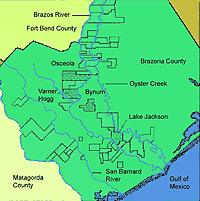
Map of Brazoria County, with locations
of four early sugar plantations, including Lake Jackson.
|
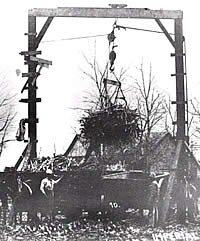
Loading sugar cane into wagons at
Sugarland, Brazoria County. Date unknown. Photograph
courtesy of Brazoria County Historical Museum.
|
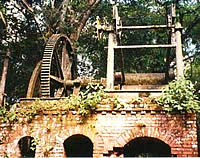
Indian Church sugar mill in Belize.
The cane crushers are still in place along with the
flywheel and engine that powered the mill. Photo courtesy
of Don McCormick.
|
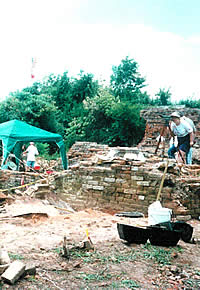
Sugar mill excavations looking west.
The large ruin in the background is part of the original
Jackson period cane crusher foundation. The bricks in
the foreground are part of the convict period boiler
foundations.
|
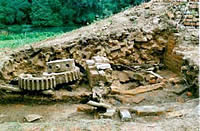
On the right is the base of the foundation
for the cane crushers. On the left are two fragments
of the gears that turned the crushers. In the center
are the bands that held together the horse-powered treadmill.
|
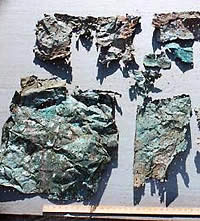
Fragments of the copper sieve that
was placed just below the cane crushers. The sieve prevented
fragments of the cane plant from getting into and contaminating
the cane juice.
|
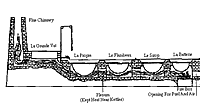
A train of kettles from an 1857 drawing
by Henry Olcott. Of the five iron kettles, the largest
was La Grande (shown in this drawing as a vat) and the
smallest was La Batterie. The fire was under La Batterie;
the heat from the fire was drawn under the other kettles
and then up the flue chimney. The kettles were completely
enclosed by a brick foundation and plastered to contain
the heat.
|
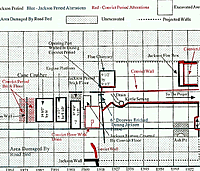
Plan of the Jackson period sugar
mill and convict mill, drawn after excavations were
completed. Archeologists noted differences over time,
including changes in the area of the kettles. The arrangement
of kettles was the same but the flue chimney was completely
sealed off in the convict mill. The convict period added
a foundation for the new boilers to heat the kettles
and raised the floors.
|
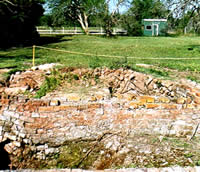
An example of convict construction
at Lake Jackson, showing the poor quality masonry work.
Note the sagging line of bricks in the foundation.
|
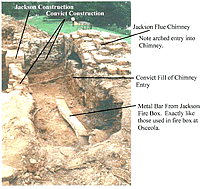
This photo shows how the flue chimney
was blocked by a convict wall. The large metal bar
is identical to the bars in the firebox at the Osceola
Mill. It has been "tossed" because it was
no longer needed.
|
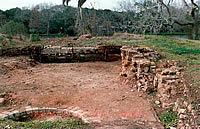
In the lower part of this photo,
the lime well from the Jackson period and the Jackson
floor are visible. To the right is a doorway between
the mill proper and the purgery that was sealed during
the convict period. Convicts built the wall in the center
on top of the Jackson wall; metal bars were used to
stabilize the addition. The original kettle settings
had to be torn apart to place steam coils around the
kettles when the "steam train" method for
heating the kettles was implemented. The firebox was
removed, and the flue chimney blocked by a wall.
|
|
The Lake Jackson mill may be the only mill in Texas
with preserved evidence of the steam train technology
available for archeological study.
|
|
The first refineries in Texas were sugar mills
that turned the juice of sugar cane into granulated sugar.
Sugar cane is not native to the Americas. Its origin lies
in Southeast Asia. Christopher Columbus brought sugar cane
to the island of Santo Domingo on his second voyage, and from
there it spread to North, Central, and South America.
When Moses Austin visited the Spanish Governor
in San Antonio, Texas, in 1820, he expressed his hope of bringing
300 families to Texas to raise cotton and sugar. The Governor
knew that sugar cane would grow in Texas—a small sugar
mill already had been established at Mission San Jose y San
Miguel de Aguayo in San Antonio sometime before 1755. Although
Moses Austin received his impresario grant, he died soon after
his return to Missouri, leaving his son, Stephen, to assume
his father's mission. Stephen F. Austin traveled to Texas
to choose the best land to raise sugar cane: the land near
the Brazos and Colorado Rivers. The alluvial soils of this
Gulf Coast Plain were a source of great wealth for the sugar
planters. The Brazos and San Bernard rivers, Oyster Creek,
and numerous meandering bayous, provided transportation.
By 1828, the first sugar mill in Austin's Colony
had been established and by 1850, there were 45 large plantations
producing millions of pounds of sugar a year. African-American
slaves provided most of the labor. The Civil War devastated
the sugar economy in Texas. After the war, Texas planters
began to revive the sugar industry using convict labor. The
Imperial Sugar Company began with the 1875 partnership of
Edward H. Cunningham and Colonel Littleberry A. Ellis. To
operate their sugar lands, they leased the entire Texas prison
population and sublet those laborers they did not need. In
the 1890s, Colonel Cunningham built a mill and installed the
machinery needed to refine sugar. In 1905, it became Cunningham
Sugar Company and in 1917, the Imperial Sugar Company.
Sugar production in Texas peaked in the 1880s
and declined afterwards as the trend toward consolidation
of sugar mills developed. The industry took a bigger blow
in 1910 when a new law prohibited the leasing of any convicts;
thus the sugar mills lost the majority of their work force.
Sugar cane is no longer grown commercially along the upper
Texas Gulf coast. Nonetheless, the Imperial Sugar Company
in Sugar Land, Texas still refines sugar imported from Hawaii,
Louisiana, and Puerto Rico.
From Stalk to Sugar: The Sugar-Making Process
Sugar was made in nineteenth-century Texas mills
by a very involved and complex process. The first stage—extraction—entailed
squeezing the juice from ripe sugar cane with steam-powered
crushers. The juice was pulled by gravity from upstairs crushers
to the first floor vats. The earliest mills in Texas used
horsepower to drive wooden rollers to extract the cane juice.
In 1843, the first steam-powered mill was established on Captain
William Duncan's Caney Creek plantation.
The second phase of sugar production was the
reduction process which requires a fire, a train of progressively
larger kettles, and the flue chimney. Heat was produced by
a fire under the smallest of the kettles (usually about 6
feet in diameter). The heat was then pulled by the height
of the chimney through the flue under the kettles to where
it exited up the tall chimney. The molten sugar scum was repeatedly
skimmed from the top of each vat as the liquid was passed
on down to the smallest kettle.
The final phase of the sugar process was granulation,
cooling, and purging, which took place in the purgery—a
large space attached to the reduction room to hold cooling
trays and vats. When the syrup in the smallest and hottest
kettle began to crystallize, it was removed into cooling trays.
Cooling trays were usually wooden troughs about 10 feet long,
5 feet wide, and 10-12 inches deep. After about 30 days, the
uncrystallized syrup,or molasses, was drained into a molasses
barrel leaving behind crystallized sugar.
Investigating Historic Mills
With knowledge of the sugar-making process,
archeological investigators formulated specific research questions
prior to beginning excavations at Lake Jackson.
- What was the layout of the original Lake
Jackson mill? Was it similar to or different from other
sugar mills in Texas?
- How was the mill changed when steam power
was added? The historic record documents the addition of
steam power to operate the cane crushers. Where were the
boiler, boiler chimney and engines located?
- How was the mill altered after the Civil
War when steam replaced fire as the source of heat in the
reduction process?
Prior to excavating the Lake Jackson mill, three
historic Texas sugar mills—Bynum, Osceoloa, and Varner-Hogg—were
mapped to distinguish similarities and differences. Although
all are in ruin, the remains are substantial enough to identify
the main components.
Osceola Mill is the best-preserved mill and
made identification of the shared attributes of the other
mills possible. It was determined that all three are long
and narrow and have cisterns close to them. They all have
the flue chimney outside the structure and they are all divided
into two parts, the crushing area and the purgery. At Osceola
and Bynum, the boiler chimneys could be identified; both are
outside the sugar mill.
Tracing the Sugar Making Process at Lake
Jackson
To recap, the three processes in making sugar
are, extraction, reduction, and crystallization. The extraction
process extracts the juice from the sugar cane. This process
is done with large iron crushers that were powered by a horse-powered
treadmill attached to the crushers or by a steam boiler which
provided steam power to turn the cane crushers.
The historical records state that Jackson began
the mill using horsepower to run the cane crushers that extracted
the juice from the cane. The tallest part of the mill ruins
was the foundation for the massive cane crushers placed on
the second flour. As investigations got underway on the brick
floor next to the cane crusher foundation, excavators uncovered
horse harnesses and large metal bands.
Although records indicate that Jackson installed
a boiler to steam power the cane crushers, neither the boiler
nor the boiler chimney were found during extensive excavations.
All evidence indicates that the horse-powered treadmill was
still in place when the mill was destroyed by the 1900 hurricane.
The second phase of sugar making is the reduction
process that boils the cane juice until the juice crystallizes
into granulated sugar. In the original Jackson mill, sugar
cane juice was reduced to a granular form in a "train
of kettles," a series of large to small kettles heated
by a fire under the smallest kettle. The heat from the fire
was pulled through the flue, under the series of kettles,
by the draft of a flue chimney. Excavators identified the
opening of the flue chimney and the flue chimney foundation
at the Lake Jackson mill, along with the circular brick remains
of the kettle settings.
When the sugar began to crystallize in the smallest,
hottest kettle, the thick syrup was removed to cooling trays
where the crystallization process continued. When the
sugar cooled, it was placed in hogsheads, storage barrels,
where the remaining molasses, uncrystallized syrup, was allowed
to drain out of the hogsheads. The room where this separation
occurred was called the purgery. Each hogshead contained about
a thousand pounds of sugar. About three barrels of molasses
were drained from each hogshead. The molasses was shipped
to the Caribbean to be made into rum.
Post Civil-War Sugar Production
An inventory of property at Lake Jackson Plantation
in 1878 documents the change from fire to heat the sugar kettles
to the use of steam as a heat source. By this time, the Jackson
family no longer owned the plantation. The new owners completely
converted the mill to adapt to steam power to heat the kettles.
The kettles were stripped of their foundations, steam coils
were wrapped abound the kettles to provide a more regulated
heat and the kettle foundations were rebuilt.
In addition to the changes in sugar making technology,
a major change was made in the labor force at the mill: convicts
replaced the slaves. After the Civil War, the state of Texas
rented out their convicts as a labor supply.
Differences in workmanship between the Jackson
period construction and convict labor period became increasingly
apparent during excavations. During the Jackson period, bricks
made by the slaves were uniform in size, clay was high quality,
and firing was regular. Only whole bricks were used, and walls
were constructed with exceptional craftsmanship. In contrast,
convicts were poor masons and used low-quality materials.
They used bricks of different sizes, including fragmentary
pieces, in their construction and applied mortar irregularly.
Walls and foundations tended to slope and buckle over time.
Other evidence helped archeologists distinguish construction
of the two periods. For example, alterations made by convict
labor after 1873 include:
Blocked Passageways: A blocked doorway
was found in the wall separating the kettle area from the
purgery. The east side of the wall shows an enclosed portal
with plastered walls, while the west side has very sloppy,
and uneven rows of bricks with "bleeding" mortar.
The door between the crusher foundations and the kettle area
was also closed with a brick wall.
Raised Walls: The east/west wall, the
south wall of the Jackson kettle enclosure, is an excellent
example of a raised wall. Attached to the Jackson wall, iron
masonry braces were placed about every four or five feet and
a new section of wall was added. This alteration may be a
result of the change from fire heat (train of kettles) to
steam heat (steam train). The upper portion of the train of
kettles would have been removed to expose the sides of the
kettles. After steam coils were wrapped around the kettles,
then the kettle area would have been sealed to enclose the
kettles and contain the heat. This would explain convict walls
on top of plantation walls in the kettle area.
Raised Floors: The lower Jackson floor
is like the Jackson foundation and walls in construction;
substantial, level, and with excellent masonry. The lime pit
and original Jackson floor found in 1994 became the cornerstone
for all other Jackson floor identifications. The upper or
raised convict floors are uneven. When the floor is of brick,
it is one brick thick and of poor masonry construction. Convict
period floors are also of dirt and had between 1 - 1.25 feet
of fill between the Jackson floor and the convict floor.
Blocked Chimney: The flue chimney opening
was closed by bricks and was separated from the kettle area
by a brick wall during the Convict Period alterations.
Firebox removed: The brick foundation
and grates of the firebox were removed and the opening to
the firebox on the north wall was closed with a brick wall.
In 1995, more of the original Jackson plantation floor was
uncovered along with a kettle setting and a heat flue in the
middle of the sugar mill. Since 1995, the other original kettle
settings have been located and the boiler and engine platforms
of the Convict period have been identified.
Putting the Pieces Together
Excavations revealed the components of the original
Jackson mill: the horse treadmill that supplied the original
power; the foundation for the cane crushers; the original
train of kettles with fire box, kettle settings and flue chimney;
and the purgery and storage area. By comparing the Lake Jackson
mill to Osceola, Varner-Hogg and Bynum, it was learned that
these four mills in Brazoria County were very similar in design
and layout—reflecting a shared process. Historic records
state that the mills at Retrieve and Darrington—Jackson's
other plantations—had double rows of kettles, called
a double train. These two plantations are now state prisons.
Although historic records document the addition
of steam power to operate the cane crushers, the boiler and
boiler chimney were not located during excavations. The foundation
for the cane crushers probably remained the same. The change
was from wooden to metal rollers to crush the cane. The heavier
weight of the metal rollers may have required a more substantial
foundation and the original foundation may have been augmented.
After the Civil War, the mill was significantly
altered in the transition to the "steam train" method.
The cane crushing area is the only portion of the mill that
not altered by the change. Addtionally, in the area between
the large foundations of the crushers and the kettle area,
the floor was raised with rubble about 1.5 feet above the
Jackson floor. A single brick thick floor was laid on the
rubble that contained a hole and drain. The train of kettles
was torn apart, the firebox was removed, and the top portion
of the kettle supports was removed to expose the kettles.
The kettles were wrapped with steam coils of metal that were
connected to the newly installed boilers. The kettle supports
were then rebuilt resulting in convict construction on top
of Jackson construction. Metal rods supported the new construction.
The area around the open kettles would have been sealed to
keep heat from escaping from below the kettles.
Since fire was no longer a source of heat, the
flue chimney was bricked closed and a wall built separating
the chimney from the mill; the area became a trash dump. A
new foundation for the new boilers was constructed north of
the mill, close to the location of the kettles.
What was the purpose in changing to steam heat?
According to George Olcott, who studied the sugar making process
during the mid-nineteenth century, "Steam does not discolor
the sugar nearly so much as fire, therefore steam trains have
been extensively adopted, and great expense has frequently
been incurred in altering the arrangement of the boiling-house
to suit the new regime. A steam train will cost twice
as much to run and keep in order as a common train will, to
say nothing of the first expense…" Many mill operators
claimed the heating of the kettles was easier to control but
workers had to be highly trained to make the process work.
Because so many Texas sugar mills have been
completely destroyed or are in ruins, and because the historical
record is incomplete, we do not know how many sugar mills
changed to the steam train method. The Lake Jackson mill may
be the only mill in Texas with preserved evidenced of this
technology.
|
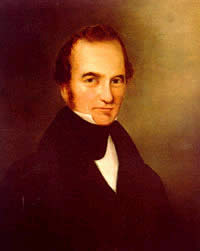
Stephen F. Austin followed through
on the dream of his father, Moses Austin, to establish
colonies in Texas and raise cotton and sugar. Image
courtesy of the Texas State Library and Archives.
Click images to enlarge
|
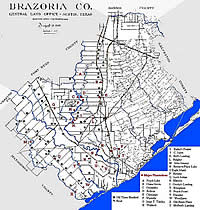
Major plantations in Brazoria County,
Texas. The success of sugar cane planters such as Abner
Jackson earned Brazoria, Fort Bend, Wharton, and Matagorda
counties the title of "sugar bowl" of Texas.
The location of two of Jackson's three plantations are
denoted by the letter "N."
|
|
Sugar cane plants at various stages
of growth. Photos courtesy of Texas Parks and Wildlife
Department and the Cooperative Extension Service, Texas
A&M University.
|
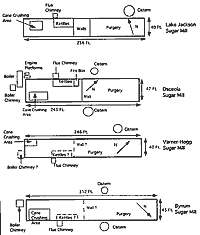
Map of ruins of four nineteenth-century
sugar mills in Texas, surveyed to provide comparative
information on size and layout.
|
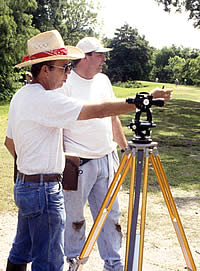
Volunteers at Lake Jackson Plantation
taking a reading with transit. Photo by Mott Davis.
|
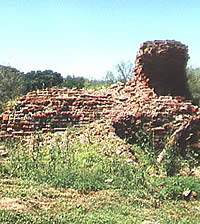
Western end of sugar mill before
excavation. The foundation of the cane crusher is in
the center. The tallest feature is the support for the
cane crusher.
|
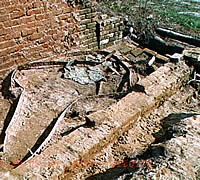
When the bands were completely exposed,
the size of the treadmill could be determined by the
circumference of the bands. The green copper sheeting
fragments are part of the copper sieve under the cane
crusher.
|
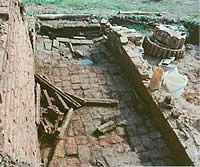
Below the bands and the sieve, excavators
found the treadmill bars and remnants of horse harnesses.
The bars were the treadmill for the horses, or mules,
and the harnesses held the animals in place.
|
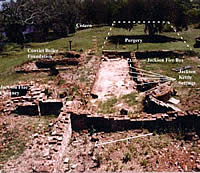
The settings for the five kettles
can be seen with the smallest kettle—which was
directly over the firebox—at the top of the series.
All of the kettles were sealed in brick and plastered
so the heat could not escape. The heat was pulled from
the firebox through the train of kettles by the height
of the flue chimney. The heat passed under all of the
kettles and out the flue chimney.
|
|
Steam does not discolor the sugar nearly so much
as fire, therefore steam trains have been extensively
adopted, and great expense has frequently been incurred
in altering the arrangement of the boiling house to
suit the new regime. —George Olcott.
|
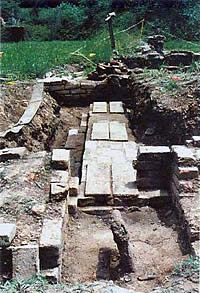
Convict period boiler and engine
foundations in the mill. In the foreground is a pipe
draining from the convict-period boilers into Lake Jackson.
In the center are the metal plates on the brick foundation
to support the boilers of the "steam train."
|
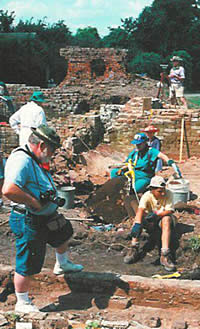
Excavators work to uncover another
area of the sugar mill. Structure I can be seen in the
background.
|
|